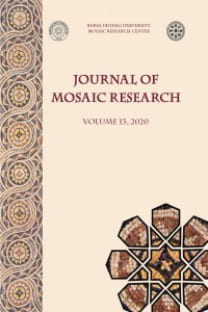Bariz Olanın Ötesine Bakmak: Mozaiklerin Mesajını Yeniden Okumak
Yüzyıllar boyunca günümüze ulaşan mozaik döşemelere baktığımızda, seçilen desenlerin birçoğunun mozaiğin yapıldığı zamana, coğrafi bölgeye, sosyal sınıfa ve topluma uyarlanmış bir dünya görüşünü yansıtan dekoratif bir gramerin parçası olduğunu görmek kolaydır.
Roma İmparatorluğu’nda Hıristiyanlığın doğuşu bir istisna değildir: geleneksel kalıplar, zamandaki ana ve yerel sosyal ve politik evrime uyarlanmış bir söylemde, yeni din tarafından “benimsenmiştir”. Belli bir anda yeni dinin bir takipçisi olarak örtülü bir özdeşleşmeye izin veren bir benimsemedir.
Bu çalışmada yazar, Lusitania’nın en batısındaki Hıristiyanlaşmanın ışığında bu kalıplardan bazılarının evriminin bir analizini sunmayı teklif etmektedir.
Anahtar Kelimeler:
Roma ve Erken Hıristiyan Sanatı, Mozaikler, Geç Antik Çağ, semiyotik, çok anlamlı göstergeler
Looking Beyond the Obvious: Rereading the Message of the Mosaics
When we look at the mosaic pavements that have come down to us over the centuries, it is easy to see that many of the patterns chosen were part of a decorative grammar that reflected a world view adapted to the geographical area, the social class and the time when the mosaic was built.
The dawn of Christianity in the Roman Empire was no exception: traditional patterns were “adopted” by the new religion, in a discourse adapted to the moment in time and to the local social and political evolution. An adoption which at a certain moment allowed a veiled identification as a follower of the new religion.
In the present intervention, the author proposes to present an analysis of the evolution of some of these patterns in the light of the Christianisation in the westernmost part of Lusitania.
___
- Bernardes - Medeiros 2016 J. P. Bernardes - I. E.Medeiros, “Boca do Rio (Budens, Vila do Bispo): novos dados de uma villa piscícola romana” RPortA 19, 265-286.
- Blazquez - Mezquíriz 1985 J. M. Blazquez - M. A. Mezquíriz, Mosaicos Romanos de Navarra, CME VII, Madrid.
- Dunbabin 1978 K. M. D. Dunbabin, The Mosaics of Roman North Africa. Studies in Iconography and Patronage, Oxford.
- Dunbabin 1999 K. M. D. Dunbabin, Mosaics of the Greek and Roman World, Cambridge.
- Duran Kremer 1998 M. de J. Duran Kremer, Algumas considerações sobre a iconografia das estações do ano. A villa romana de Pisões, D. Kremer (ed.), Homenaxe a Ramón Lorenzo, vol.I., 445-454.
- Duran Kremer 2022 M. de J. Duran Kremer, “The mosaic of Póvoa de Cós revisited . Proceedings of the 14th Conference of the Association Internationale pour l’Étude de la Mosaïque Antique”, D.
- Michaelides (ed.), Sema Ekdotike Athens-Nicosia, vol. I, 314-327.
- Duran Kremer - Serra 2022 M. de J. Duran Kremer – M. Serra, “The mosaics from the roman villa of Pisões (Beja, Portugal). The decorative programme and its significance in the spatial organisation of the villa”, JMR 15, 235-273.
- Fugger 2017 V. Fugger, “Shedding Light on Early Christian Domestic Cult: Characteristics and New Perspectives in the Context of Archaeological Findings”, ArchRel 18/19, 201-235.
- Geertz 1987 C. Geertz, Dichte Beschreibung: Beiträge zum Verstehen kultureller Systeme. Suhrkamp Taschenbuch Wissenschaft.
- Guardia 2015 M. Guardia, MOSAICO DE LA BASÍLICA DE S’ILLA DEL REI, Coléccion La pieza del Mes, Museu de Menorca. https://www.museudemenorca.com/es/coleccion/leer/mosaico-de-la-basilica-de-silla--del-rei-/61.
- Heitlinger 2021 P. Heitlinger, A Cuitura Visigótica na Hispânia: Monarcas, Monumentos, Manuscritos, Leis, Jóias, Arte, Musica e Arquitectura, Edições de Arqueologia, 5ª Edição 2021, http://tipografos.net/ebooks/Cultura-visigotica-prova.pdf
- Limão 2011 F. Limão, “The Vase’s Representation (Cantharus, Crater) on the Roman Mosaic in Portugal: A Significant Formal and Iconographic Path from Classic Antiquity to Late Antiquity”, M. Şahin (ed.), 11th International Colloquium on Ancient Mosaics, Bursa, 565-583.
- Maciel 1996 M. J. Maciel, Antiguidade Tardia e Paleocristianismo em Portugal, Edições Colibri, Lisboa.
- Metz 2020 S. Metz, “Die Begegnung von Hahn und Schildkröte. Kultursemiotische Betrachtungen zu einem spätantiken Bodenmosaik in der Basilika von Aquilea”, Chances and Problems of Cultural Anthropological Perspectives in Ancient Studies, Distant Worlds Journal 4, 107-123.
- Museu 1961 Museu Regional de Beja, Catálogo de Algumas das Principais Peças, Ed. Junta Distrital de Beja.
- Palol 1967 P. de Palol, Arqueologia Cristiana de la España Romana, Siglos IV-VI, España Romana, I, Madrid-Valladolid .
- Patrocínio 2012 M. F. S. Patrocínio, Património Religioso Cristão em Portugal: A memória dos primeiros programas edificados. Actas do Ciclo de Conferências sobre “Religião e Património” associado à exposição aFÉ[tos], Évora, 1-18.
- Pessoa 2007 M. Pessoa, “Mosaicos da uilla romana do Rabaçal, Penela, Portugal. Prelúdio de Arte Bizantina?”, Revista de História da Arte 3, 85-101.
- Pessoa 2008 M. Pessoa, “Um stibadium com mosaico na villa romana do Rabaçal. De cenário áulico a chão de culto cemiterial”, Revista de História da Arte 6, 138-159.
- Pessoa 2017 M. Pessoa, A villa do Rabaçal, Penela. Corpus dos Mosaicos Romanos de Portugal 2, Câmara Municipal de Penela.
- Posner 2001 R. Posner, Kultursemiotik. https://www.semiotic.tu-berlin.de>fileadmin/fg150/Posner-Texte/Posner-Kultursemiotik.
- Souza 1990 V. de Souza, Corpus Signorum Imperii Romani, Corpus der Skulpturen der Römischen Welt, Portugal, Instituto de Arqueologia da Faculdade de Letras de Coimbra, Coimbra.
- Veiga 1910 E. da Veiga, “Tempos Históricos”, APort 15, 212-218.
- ISSN: 1309-047X
- Başlangıç: 2008
- Yayıncı: Ululdağ Üniversitesi, Mozaik Araştırlmaları Merkezi
Sayıdaki Diğer Makaleler
Altın Sarısı ve Mavi Geҫişi - Tarihi Bir Yerde Çağdaş Bir Gerçekleşme
Cristina COCCIA, Ilaria Marta CARRA, Maria Benedetta GANDINI, Paola PERPIGNANI, Simone ZAMBRUNO
Bezemelerin Simetrilerinde Saklı Olan Ortaçağ Kültür İlişkileri
Pompeii İskender Mozaiği’ndeki Antik Dönem Onarımları
Ashdod Maritima, İsrail’de Yeni Keşfedilen Dini Kompleksin Mozaik Zeminlerindeki İnanç Sembolleri
Matematik Teoremlerinin Antik Dönem Mozaikleri Üzerinde Tespiti
Sırrı ÇÖLMEKÇİ, Emrah KAHRAMAN, Emir SON
Nil Nehri’nin Mozaiklerdeki Temsili: Çeşitli Bağlamlar, Çeşitli Anlamlar
